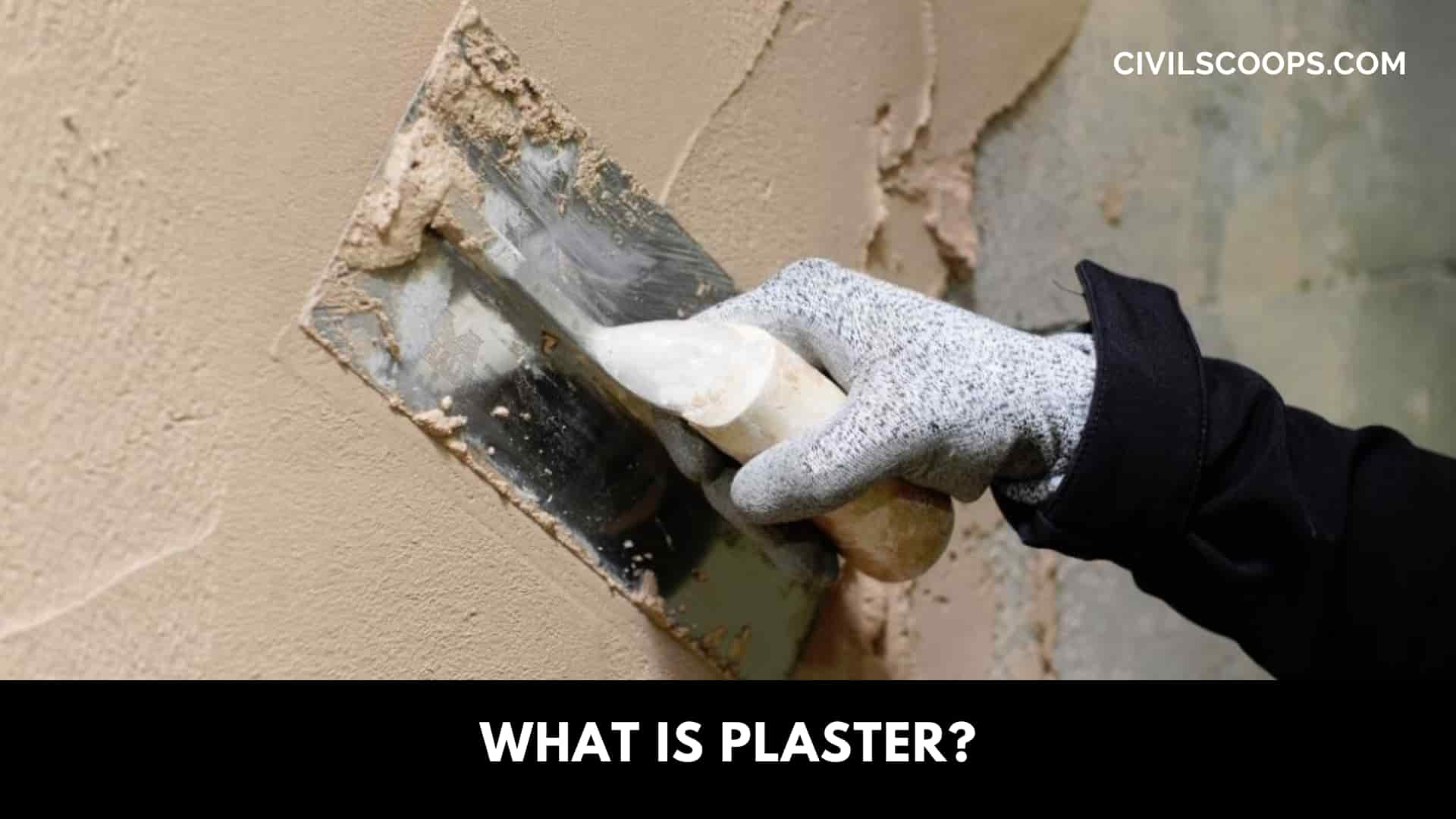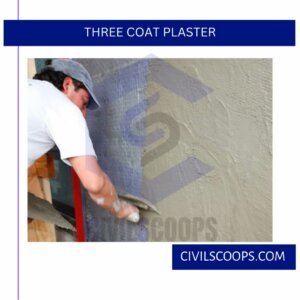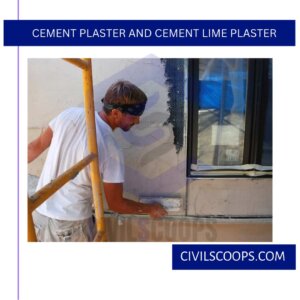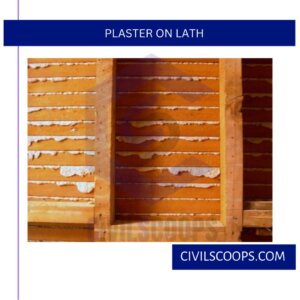What Is Plaster | Methods of Plastering

Table of Contents
What Is Plaster?

This id the process of covering rough walls, uneven surfaces in the construction house and other structures with a plastic material, called plaster or mortar.
Sometimes, the term ‘rendering’ is used instead of plastering when the plaster or cement is applied to the external surface of the wall either to improve the appearance or to protect then from wether agencies, such as rain heat, etc.
Also Read: 14 Types of Plaster Finishes (List of Plaster Finishing)
Methods of Plastering

Plater is applied in the manner mention below. To get uniform 150 x 150 mm and 10 mm thick dots are prepared on the surface at a lower level.
Those dots are transferred on the upper level with a plumb bob, so the dots of the upper level and lower come in one and vertical surface.
In this, any dots are applied on all the surface of the wall at 1500 to 2000 mm. Four dots are covered masonry with the help or screed, and plaster is applied properly.
Lime plaster is applied in these coats or in three coats or in two cots. The background is prepared before applying plaster.
- Three Coat Plaster
- Application of Rendering Coat
- Application of Floating Coat
- Application of Finishing Coat
- Two Coat Plaster
- Cement Plaster and Cement Lime Plaster
- Two Coat Plaster
- Three Coat Plaster
- Single Coat Plaster
- Plaster on Lath
- Wooden Laths
- Metal Lath
1. Three Coat Plaster

The procedure of applying three-coat plaster is similar to two-coat plaster only difference is that an intermediate coat is known as a floating coat. The purpose of this coat is to bring the plaster to an even surface.
In the case of 3-coat plaster, the first coat is known id rendering coat, the second coat is known as a floating coat, and third coat is known as setting coat or finishing coat.
The rendering coat is applied, and scratches are made. The floating coat is applied, and after seven days finished coat is applied, after 6 hours of applying a floating coat.
1.a. Application of Rendering Coat
The mortar is applied forcibly on the surface of wall. With masons trowel and pressed well into joints and over the surface.
The thickness of the coat should be such as to cover all inequalities of the surface normally this thickness is 12mm.
This coat is allowed to harden slightly a then scratch marks are made on the surface with the help of trowel ledge. During this period, the surface is curved and then allowed to dry completely.
1.b. Application of Floating Coat
The first coat is prepared properly to apply the second coat, i.e., a floating coat. All dirt and dust are cleared. It is wetted properly.
10 cm wide strips or 15 cm x 15 cm patches are applied at a suitable distance. These patches or strips act as a gauge for thickness or floating coat.
The mortar is dashed with mason’s trowel, spread, and rubbed to the required plain surface with a wooden float.
The floating coat is beaten with floats edge at the close spacing of cm. Then it is allowed to dry completely. The thickness or floating coat is 6 to 9 mm.
1.c. Application of Finishing Coat
The third coat is called a finishing coat. In the Case of lime-sand mortar, the finishing coat is applied immediately after the floating coat cream of lime and sand in 4:1 are applied with a steel trowel and rubbed and finished smooth.
The rubbing is done till the finishing coat is quite dry. Then curing is done after one day for seven days.
2. Two Coat Plaster

The joints are ranked at a depth of 20 mm. The surface is cleaned, and water is sprinkled property on it.
- Before the first coat is applied preliminary coat is applied to make an uneven surface in le.
- Then, the first coat is applied. The first coat is racked as a rendering coat. The thickness first coat is kept 2 to 3 mm less than a total thickness of plaster.
To maintain interim thickness and vertically of plaster 15 cm * 15 cm dots or are provided, Then a vertical strip of mortar known as the spread is formed at a distance of 2 m. spacing.
Then the spaces between screeds are filled with mortar and properly finished.
- Scratches are made on rendering coat to provide mechanical key before it hardens. The rendering coat is watered for 2 days and then dried.
Before applying the final/coat, the rendering coat is damped well. The final coat is applied with wooden floats to a true even surface with steel trowels. The thickness of the final coat may vary from 2 to 3 mm.
3. Single Coat Plaster

This is used only in interior quality work. It is applied similar to two coat plaster except that the rendering coat as applied fro two-coat plaster is finishing off immediately after it has sufficiently hardened.
4. Cement Plaster and Cement Lime Plaster

For interior work single coat plaster is applied. For good quality works, either two coat or three coat plaster is applied. But two coat plaster is more common sow shall discuss it first.
5. Plaster on Lath

Thin partition walls and ceilings are plastered using laths. Laths are provided as a foundation to receive plasterwork. Laths may be.
- Wooden laths
- Metal laths
5.a. Wooden Laths
Wooden laths are well seasonal wooden strips 25 mm wide and 1 to 1.2 m long. Wooden laths are used and ceilings.
Laths are fixed in a parallel line with a clear spacing of 10 mm and secured to the surface with galvanized iron nails.
5.b. Metal Laths
Metal laths are available under various patent names. The plain expanded metal lath(exam) is commonly metal laths are fixed to the surface by G.I Staples.
In the case of concrete or masonry surfaces, wooden plugs have to be embedded for fixing the lath. After fixing the lath, the surface is plastered, usually, in there coats, cement mortar is used.
[su_box title=”FAQ” style=”default” box_color=”#333333″ title_color=”#FFFFFF” radius=”3″ class=”” id=””]
Plaster
A soft mixture of lime with sand or cement and water for spreading on walls, ceilings, or other structures to form a smooth hard surface when dried.
What Is Plaster Made Of?
Plaster, a pasty composition (as of lime or gypsum, water, and sand) that hardens on drying and is used for coating walls, ceilings, and partitions. Plastering is one of the most ancient building techniques.
Types of Plaster Walls
Types
- Clay plaster.
- Gypsum plaster (plaster of Paris)
- Lime plaster.
- Cement plaster.
- Heat-resistant plaster.
Is Plaster Waterproof?
Polished or Venetian plaster in its natural form is not waterproof, you can apply wax or some sealants to make it water resistant but it will never be totally waterproof.
Gypsum Plaster
Gypsum plaster is a white cementing material made by partial or complete dehydration of the mineral gypsum, commonly with special retarders or hardeners added. Applied in a plastic state (with water), it sets and hardens by chemical recombination of the gypsum with water.
Cement Plaster
A mortar consisting of portland cement, sand, and water used for plastering interior surfaces of a building
What Is Bonding Plaster?
A plaster with high adhesive properties made especially for use as a first coat on interior concrete surfaces.
Different Plastering Techniques
Types of Plaster Finishes used in Building Construction are:
- Smooth cast finish.
- Rough cast finish.
- Sand faced finish.
- Pebble dash finish.
- Scrapped finish.
- Depeter finish.
- Textured finish.
Traditional Plastering Methods
Traditional plasterwork is usually either earth or lime based. The two main methods of using lime plaster as an internal finish are either to apply it directly onto masonry, commonly referred to as plaster on the hard, or onto a backing of timber laths.
How Is Plaster Made?
It is produced by heating gypsum to around 150°C (300 °F). When mixed with water, the dry plaster powder re-forms into gypsum. Unmodified plaster starts to set about 10 minutes after mixing, but it will not be fully set until 72 hours have elapsed. Gypsum plaster has good fire-resistant qualities.
How Many Coats of Plaster?
You should prepare to apply at least two coats, in order to achieve a smooth finish. However, if you can still see obvious grooves and indents after the second coat dries, you can trowel on a third coat
Properties of Plaster
The ability of plaster to withstand weathering includes resistance to wind and rain penetration, resistance to freezing and thawing, and resistance to thermal and moisture changes. Resistance to aggressive chemicals in the atmosphere, such as acid rain, is also of concern.
Lath and Lime Plaster
Lath and lime plaster is a building technique used mainly for interior walls in period buildings. A lath is a narrow strip of wood approximately 2 inches wide which is nailed horizontally to each stud in the frame.
How to Repair Plaster?
Step 1: Remove Damaged Plaster. Remove the damaged plaster by using a cold chisel and a ball peen hammer to chip the damaged plaster off the wall.
Step 2: Apply Latex Bonding Agent.
Step 3: Apply and Cross-Scratch Plaster.
Step 4: Apply Second Layer.
Step 5: Apply layer of Joint Compound.
[/su_box]
[su_note note_color=”#F2F2F2 ” text_color=”#333333″ radius=”3″ class=”” id=””]
Like this post? Share it with your friends!
Suggested Read –
- All About Drywall Water Damage Repair
- All About Asphalt Flooring | What is Asphalt Flooring | Asphalt Flooring Used | Asphalt Flooring Advantages and Disadvantages
- What Are the Differences Between Shear Slump and Collapse Slump in Slump Test?
- What Is Glass | Types of Glass Used in Construction | Qualities of Glass | Advantages & Disadvantages of Glass
- What Is Hempcrete | Hempcrete Blocks | Advantages & Disadvantages of Hempcrete Blocks | Applications of Hempcrete
[/su_note]
